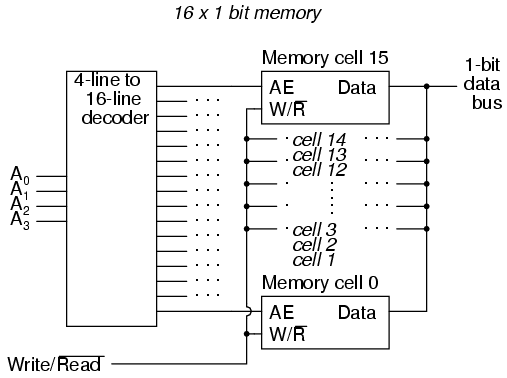When we store information in some kind of circuit or device, we not only need some way to store and retrieve it, but also to locate precisely where in the device that it is.
Most, if not all, memory devices can be thought of as a series of mail boxes, folders in a file cabinet, or some other metaphor where information can be located in a variety of places. When we refer to the actual information being stored in the memory device, we usually refer to it as the data. The location of this data within the storage device is typically called the address, in a manner reminiscent of the postal service.
With some types of memory devices, the address in which certain data is stored can be called up by means of parallel data lines in a digital circuit (we’ll discuss this in more detail later in this lesson). With other types of devices, data is addressed in terms of an actual physical location on the surface of some type of media (the tracks and sectors of circular computer disks, for instance).
However, some memory devices such as magnetic tapes have a one-dimensional type of data addressing: if you want to play your favorite song in the middle of a cassette tape album, you have to fast-forward to that spot in the tape, arriving at the proper spot by means of trial-and-error, judging the approximate area by means of a counter that keeps track of tape position, and/or by the amount of time it takes to get there from the beginning of the tape.
The access of data from a storage device falls roughly into two categories: random access and sequential access. Random access means that you can quickly and precisely address a specific data location within the device, and non-random simply means that you cannot.
A vinyl record platter is an example of a random-access device: to skip to any song, you just position the stylus arm at whatever location on the record that you want (compact audio disks so the same thing, only they do it automatically for you). Cassette tape, on the other hand, is sequential. You have to wait to go past the other songs in sequence before you can access or address the song that you want to skip to.
The process of storing a piece of data to a memory device is called writing, and the process of retrieving data is called reading. Memory devices allowing both reading and writing are equipped with a way to distinguish between the two tasks, so that no mistake is made by the user (writing new information to a device when all you wanted to do is see what was stored there).
Some devices do not allow for the writing of new data, and are purchased “pre-written” from the manufacturer. Such is the case for vinyl records and compact audio disks, and this is typically referred to in the digital world as read-only memory, or ROM. Cassette audio and video tape, on the other hand, can be re-recorded (re-written) or purchased blank and recorded fresh by the user. This is often called read-write memory.
Another distinction to be made for any particular memory technology is its volatility, or data storage permanence without power. Many electronic memory devices store binary data by means of circuits that are either latched in a “high” or “low” state, and this latching effect holds only as long as electric power is maintained to those circuits. Such memory would be properly referred to as volatile.
Storage media such as magnetized disk or tape is non-volatile, because no source of power is needed to maintain data storage. This is often confusing for new students of computer technology because the volatile electronic memory typically used for the construction of computer devices is commonly and distinctly referred to as RAM (Random Access Memory).
While RAM memory is typically randomly-accessed, so is virtually every other kind of memory device in the computer! What “RAM” really refers to is the volatility of the memory, and not its mode of access. Nonvolatile memory integrated circuits in personal computers are commonly (and properly) referred to as ROM (Read-Only Memory), but their data contents are accessed randomly, just like the volatile memory circuits!
Finally, there needs to be a way to denote how much data can be stored by any particular memory device. This, fortunately for us, is very simple and straightforward: just count up the number of bits (or bytes, 1 byte = 8 bits) of total data storage space.
Due to the high capacity of modern data storage devices, metric prefixes are generally affixed to the unit of bytes in order to represent storage space: 1.6 Gigabytes is equal to 1.6 billion bytes, or 12.8 billion bits, of data storage capacity.
The only caveat here is to be aware of rounded numbers. Because the storage mechanisms of many random-access memory devices are typically arranged so that the number of “cells” in which bits of data can be stored appears in binary progression (powers of 2), a “one kilobyte” memory device most likely contains 1024 (2 to the power of 10) locations for data bytes rather than exactly 1000.
A “64 kbyte” memory device actually holds 65,536 bytes of data (2 to the 16th power), and should probably be called a “66 Kbyte” device to be more precise. When we round numbers in our base-10 system, we fall out of step with the round equivalents in the base-2 system.

